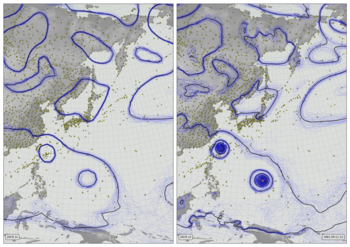The Gold Coast Cyclone (1954) video¶
The thin blue lines are mslp contours from each of 56 ensemble members (all members for v2c, the first 56 members for v3). The thicker black lines are contours of the ensemble mean. The yellow dots mark pressure observations assimilated while making the field shown. The red dots are the IBTRACS best-track observations for the Gold Coast cyclone.
Download the data required:
#!/usr/bin/env python
import IRData.twcr as twcr
import datetime
dte=datetime.datetime(1954,2,1)
for version in ('2c','4.5.1'):
twcr.fetch('prmsl',dte,version=version)
twcr.fetch_observations(dte,version=version)
Script to make an individual frame - takes year, month, day, and hour as command-line options:
#!/usr/bin/env python
# Tasman region weather plot
# Compare pressures from 20CRV3 and 20CRV2c
# Video version.
import os
import math
import datetime
import numpy
import pandas
import iris
import iris.analysis
import matplotlib
from matplotlib.backends.backend_agg import \
FigureCanvasAgg as FigureCanvas
from matplotlib.figure import Figure
import cartopy
import cartopy.crs as ccrs
import Meteorographica as mg
import IRData.twcr as twcr
# Get the datetime to plot from commandline arguments
import argparse
parser = argparse.ArgumentParser()
parser.add_argument("--year", help="Year",
type=int,required=True)
parser.add_argument("--month", help="Integer month",
type=int,required=True)
parser.add_argument("--day", help="Day of month",
type=int,required=True)
parser.add_argument("--hour", help="Time of day (0 to 23.99)",
type=float,required=True)
parser.add_argument("--opdir", help="Directory for output files",
default="%s/images/Gold_Coast_Cyclone" % \
os.getenv('SCRATCH'),
type=str,required=False)
args = parser.parse_args()
if not os.path.isdir(args.opdir):
os.makedirs(args.opdir)
dte=datetime.datetime(args.year,args.month,args.day,
int(args.hour),int(args.hour%1*60))
# HD video size 1920x1080
aspect=16.0/9.0
fig=Figure(figsize=(10.8*aspect,10.8), # Width, Height (inches)
dpi=100,
facecolor=(0.88,0.88,0.88,1),
edgecolor=None,
linewidth=0.0,
frameon=False,
subplotpars=None,
tight_layout=None)
canvas=FigureCanvas(fig)
# HK-centred projection
projection=ccrs.RotatedPole(pole_longitude=335, pole_latitude=125)
scale=30
extent=[scale*-1*aspect/2,scale*aspect/2,scale*-1,scale]
# Two side-by-side plots
ax_2c=fig.add_axes([0.01,0.01,0.485,0.98],projection=projection)
ax_2c.set_axis_off()
ax_2c.set_extent(extent, crs=projection)
ax_3=fig.add_axes([0.505,0.01,0.485,0.98],projection=projection)
ax_3.set_axis_off()
ax_3.set_extent(extent, crs=projection)
# Background, grid and land for both
ax_2c.background_patch.set_facecolor((0.88,0.88,0.88,1))
ax_3.background_patch.set_facecolor((0.88,0.88,0.88,1))
mg.background.add_grid(ax_2c)
mg.background.add_grid(ax_3)
land_img_2c=ax_2c.background_img(name='GreyT', resolution='low')
land_img_3=ax_3.background_img(name='GreyT', resolution='low')
# Add the observations from 2c
obs=twcr.load_observations_fortime(dte,version='2c')
mg.observations.plot(ax_2c,obs,radius=0.15)
# Highlight the Hurricane obs
obs_h=obs[obs['NCEP.Type']==360]
if not obs_h.empty:
mg.observations.plot(ax_2c,obs_h,radius=0.25,facecolor='red',
zorder=100)
# load the 2c pressures
prmsl=twcr.load('prmsl',dte,version='2c')
# Contour spaghetti plot of ensemble members
mg.pressure.plot(ax_2c,prmsl,scale=0.01,type='spaghetti',
resolution=0.25,
levels=numpy.arange(870,1050,10),
colors='blue',
label=False,
linewidths=0.1)
# Add the ensemble mean - with labels
prmsl_m=prmsl.collapsed('member', iris.analysis.MEAN)
mg.pressure.plot(ax_2c,prmsl_m,scale=0.01,
resolution=0.25,
levels=numpy.arange(870,1050,10),
colors='black',
label=False,
linewidths=2)
# 20CR2c label
mg.utils.plot_label(ax_2c,'20CR 2c',
facecolor=fig.get_facecolor(),
x_fraction=0.02,
horizontalalignment='left')
# V3 panel
# Add the observations from v3
obs=twcr.load_observations_fortime(dte,version='4.5.1')
mg.observations.plot(ax_3,obs,radius=0.15)
# Highlight the Hurricane obs
obs_h=obs[obs['NCEP.Type']==360]
if not obs_h.empty:
mg.observations.plot(ax_3,obs_h,radius=0.25,facecolor='red',
zorder=100)
# load the V3 pressures
prmsl=twcr.load('prmsl',dte,version='4.5.1')
# Contour spaghetti plot of ensemble members
# Only use 56 members to match v2c
prmsl_r=prmsl.extract(iris.Constraint(member=list(range(0,56))))
mg.pressure.plot(ax_3,prmsl_r,scale=0.01,type='spaghetti',
resolution=0.25,
levels=numpy.arange(870,1050,10),
colors='blue',
label=False,
linewidths=0.1)
# Add the ensemble mean - with labels
prmsl_m=prmsl.collapsed('member', iris.analysis.MEAN)
mg.pressure.plot(ax_3,prmsl_m,scale=0.01,
resolution=0.25,
levels=numpy.arange(870,1050,10),
colors='black',
label=False,
linewidths=2)
mg.utils.plot_label(ax_3,'20CR v3',
facecolor=fig.get_facecolor(),
x_fraction=0.02,
horizontalalignment='left')
mg.utils.plot_label(ax_3,
('%04d-%02d-%02d:%02d' %
(args.year,args.month,args.day,args.hour)),
facecolor=fig.get_facecolor(),
x_fraction=0.98,
horizontalalignment='right')
# Output as png
fig.savefig('%s/V3vV2c_Gold_Coast_Cyclone_%04d%02d%02d%02d%02d.png' %
(args.opdir,args.year,args.month,args.day,
int(args.hour),int(args.hour%1*60)))
To make the video, it is necessary to run the script above hundreds of times - giving an image for every 15-minute period. The best way to do this is system dependent - the script below does it on the Met Office SPICE cluster - it will need modification to run on any other system. (Could do this on a single PC, but it will take many hours).
#!/usr/bin/env python
# Make all the individual frames for a movie
# run the jobs on SPICE.
import os
import sys
import subprocess
import datetime
max_jobs_in_queue=500
# Where to put the output files
opdir="%s/slurm_output" % os.getenv('SCRATCH')
if not os.path.isdir(opdir):
os.makedirs(opdir)
start_day=datetime.datetime(1954, 2, 17, 0)
end_day =datetime.datetime(1954, 2, 21, 23)
# Function to check if the job is already done for this timepoint
def is_done(year,month,day,hour):
op_file_name=("%s/images/Gold_Coast_Cyclone/" +
"V3vV2c_Gold_Coast_Cyclone_%04d%02d%02d%02d%02d.png") % (
os.getenv('SCRATCH'),
year,month,day,int(hour),
int(hour%1*60))
if os.path.isfile(op_file_name):
return True
return False
current_day=start_day
while current_day<=end_day:
queued_jobs=subprocess.check_output('squeue --user hadpb',
shell=True).count('\n')
max_new_jobs=max_jobs_in_queue-queued_jobs
while max_new_jobs>0 and current_day<=end_day:
f=open("multirun.slm","w+")
f.write('#!/bin/ksh -l\n')
f.write('#SBATCH --output=%s/GC_frame_%04d%02d%02d%02d.out\n' %
(opdir,
current_day.year,current_day.month,
current_day.day,current_day.hour))
f.write('#SBATCH --qos=normal\n')
f.write('#SBATCH --ntasks=4\n')
f.write('#SBATCH --ntasks-per-core=1\n')
f.write('#SBATCH --mem=40000\n')
f.write('#SBATCH --time=10\n')
count=0
for fraction in (0,.25,.5,.75):
if is_done(current_day.year,current_day.month,
current_day.day,current_day.hour+fraction):
continue
cmd=("./GC_V3vV2c.py --year=%d --month=%d" +
" --day=%d --hour=%f &\n") % (
current_day.year,current_day.month,
current_day.day,current_day.hour+fraction)
f.write(cmd)
count=count+1
f.write('wait\n')
f.close()
current_day=current_day+datetime.timedelta(hours=1)
if count>0:
max_new_jobs=max_new_jobs-1
rc=subprocess.call('sbatch multirun.slm',shell=True)
os.unlink('multirun.slm')
To turn the thousands of images into a movie, use ffmpeg
ffmpeg -r 24 -pattern_type glob -i Gold_Coast_Cyclone/\*.png \
-c:v libx264 -threads 16 -preset slow -tune animation \
-profile:v high -level 4.2 -pix_fmt yuv420p -crf 25 \
-c:a copy Gold_Coast_Cyclone.mp4
